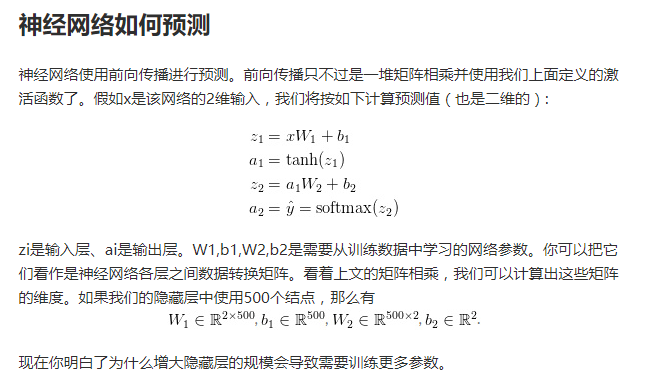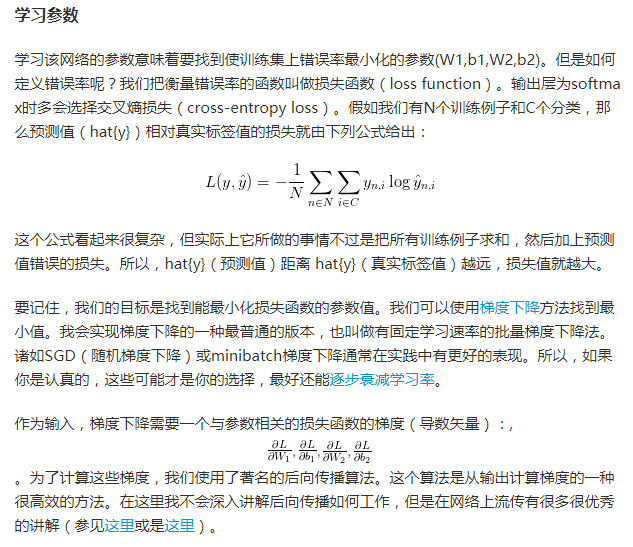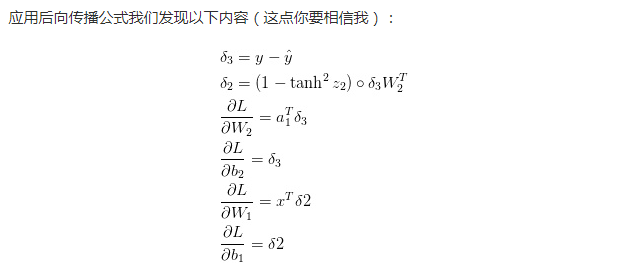参考:http://python.jobbole.com/82208/
注:1)# %matplotlib inline 注解可以使Jupyter中显示图片
2)注意包的导入方式
一、使用的Python包
1)numpy
numpy(Numerical Python)提供了python对多维数组对象的支持:ndarray,具有矢量运算能力,快速、节省空间。numpy支持高级大量的维度数组与矩阵运算,此外也针对数组运算提供大量的数学函数库。
参考:http://blog.csdn.net/cxmscb/article/details/54583415
2)sklearn
机器学习的一个实用工具,提供了数据集,数据预处理,常用的数据模型等
参考:https://www.cnblogs.com/lianyingteng/p/7811126.html
3)matplotlib
matplotlib在Python中应用最多的2D图像的绘图工具包,使用matplotlib能够非常简单的可视化数据。
参考:http://blog.csdn.net/claroja/article/details/70173026
二、神经网络学习原理



神经网络反射推到
https://www.cnblogs.com/biaoyu/archive/2015/06/20/4591304.html
交叉熵损失函数
http://blog.csdn.net/jasonzzj/article/details/52017438
三、实现思路
四、代码
1 # %matplotlib inline #add for display picture 2 import numpy as np 3 from sklearn import datasets 4 from matplotlib import pyplot as plt 5 # Generate a dataset and plot it 6 np.random.seed(0) 7 X, y = datasets.make_moons(200, noise=0.20) 8 plt.scatter(X[:,0], X[:,1], s=40, c=y, cmap=plt.cm.Spectral) 9 plt.show 10 Out[24]: 11 <function matplotlib.pyplot.show> 12 13 In [19]: 14 def plot_decision_boundary(pred_func): 15 # Set min and max values and give it some padding 16 x_min, x_max = X[:, 0].min() - .5, X[:, 0].max() + .5 17 y_min, y_max = X[:, 1].min() - .5, X[:, 1].max() + .5 18 h = 0.01 19 # Generate a grid of points with distance h between them 20 xx, yy = np.meshgrid(np.arange(x_min, x_max, h), np.arange(y_min, y_max, h)) 21 # Predict the function value for the whole gid 22 Z = pred_func(np.c_[xx.ravel(), yy.ravel()]) 23 Z = Z.reshape(xx.shape) 24 # Plot the contour and training examples 25 plt.contourf(xx, yy, Z, cmap=plt.cm.Spectral) 26 plt.scatter(X[:, 0], X[:, 1], c=y, cmap=plt.cm.Spectral) 27 In [20]: 28 from sklearn import linear_model 29 # Train the logistic rgeression classifier 30 clf = linear_model.LogisticRegressionCV() 31 clf.fit(X, y) 32 33 # Plot the decision boundary 34 plot_decision_boundary(lambda x: clf.predict(x)) 35 plt.title("Logistic Regression") 36 Out[20]: 37 <matplotlib.text.Text at 0x1d21f527f98> 38 39 In [14]: 40 # Helper function to evaluate the total loss on the dataset 41 def calculate_loss(model): 42 W1, b1, W2, b2 = model['W1'], model['b1'], model['W2'], model['b2'] 43 # Forward propagation to calculate our predictions 44 z1 = X.dot(W1) + b1 45 a1 = np.tanh(z1) 46 z2 = a1.dot(W2) + b2 47 exp_scores = np.exp(z2) 48 probs = exp_scores / np.sum(exp_scores, axis=1, keepdims=True) 49 # Calculating the loss 50 corect_logprobs = -np.log(probs[range(num_examples), y]) 51 data_loss = np.sum(corect_logprobs) 52 # Add regulatization term to loss (optional) 53 data_loss += reg_lambda/2 * (np.sum(np.square(W1)) + np.sum(np.square(W2))) 54 return 1./num_examples * data_loss 55 In [15]: 56 # Helper function to predict an output (0 or 1) 57 def predict(model, x): 58 W1, b1, W2, b2 = model['W1'], model['b1'], model['W2'], model['b2'] 59 # Forward propagation 60 z1 = x.dot(W1) + b1 61 a1 = np.tanh(z1) 62 z2 = a1.dot(W2) + b2 63 exp_scores = np.exp(z2) 64 probs = exp_scores / np.sum(exp_scores, axis=1, keepdims=True) 65 return np.argmax(probs, axis=1) 66 In [22]: 67 # This function learns parameters for the neural network and returns the model. 68 # - nn_hdim: Number of nodes in the hidden layer 69 # - num_passes: Number of passes through the training data for gradient descent 70 # - print_loss: If True, print the loss every 1000 iterations 71 def build_model(nn_hdim, num_passes=20000, print_loss=False): 72 73 # Initialize the parameters to random values. We need to learn these. 74 np.random.seed(0) 75 W1 = np.random.randn(nn_input_dim, nn_hdim) / np.sqrt(nn_input_dim) 76 b1 = np.zeros((1, nn_hdim)) 77 W2 = np.random.randn(nn_hdim, nn_output_dim) / np.sqrt(nn_hdim) 78 b2 = np.zeros((1, nn_output_dim)) 79 80 # This is what we return at the end 81 model = {} 82 83 # Gradient descent. For each batch... 84 for i in range(0, num_passes): 85 86 # Forward propagation 87 z1 = X.dot(W1) + b1 88 a1 = np.tanh(z1) 89 z2 = a1.dot(W2) + b2 90 exp_scores = np.exp(z2) 91 probs = exp_scores / np.sum(exp_scores, axis=1, keepdims=True) 92 93 # Backpropagation 94 delta3 = probs 95 delta3[range(num_examples), y] -= 1 96 dW2 = (a1.T).dot(delta3) 97 db2 = np.sum(delta3, axis=0, keepdims=True) 98 delta2 = delta3.dot(W2.T) * (1 - np.power(a1, 2)) 99 dW1 = np.dot(X.T, delta2) 100 db1 = np.sum(delta2, axis=0) 101 102 # Add regularization terms (b1 and b2 don't have regularization terms) 103 dW2 += reg_lambda * W2 104 dW1 += reg_lambda * W1 105 106 # Gradient descent parameter update 107 W1 += -epsilon * dW1 108 b1 += -epsilon * db1 109 W2 += -epsilon * dW2 110 b2 += -epsilon * db2 111 112 # Assign new parameters to the model 113 model = { 'W1': W1, 'b1': b1, 'W2': W2, 'b2': b2} 114 115 # Optionally print the loss. 116 # This is expensive because it uses the whole dataset, so we don't want to do it too often. 117 if print_loss and i % 1000 == 0: 118 print ("Loss after iteration %i: %f" %(i, calculate_loss(model))) 119 120 return model 121 In [17]: 122 num_examples = len(X) # training set size 123 nn_input_dim = 2 # input layer dimensionality 124 nn_output_dim = 2 # output layer dimensionality 125 126 # Gradient descent parameters (I picked these by hand) 127 epsilon = 0.01 # learning rate for gradient descent 128 reg_lambda = 0.01 # regularization strength 129 In [23]: 130 # Build a model with a 3-dimensional hidden layer 131 model = build_model(3, print_loss=True) 132 133 # Plot the decision boundary 134 plot_decision_boundary(lambda x: predict(model, x)) 135 plt.title("Decision Boundary for hidden layer size 3") 136 Loss after iteration 0: 0.432387 137 Loss after iteration 1000: 0.068947 138 Loss after iteration 2000: 0.068890 139 Loss after iteration 3000: 0.071218 140 Loss after iteration 4000: 0.071253 141 Loss after iteration 5000: 0.071278 142 Loss after iteration 6000: 0.071293 143 Loss after iteration 7000: 0.071303 144 Loss after iteration 8000: 0.071308 145 Loss after iteration 9000: 0.071312 146 Loss after iteration 10000: 0.071314 147 Loss after iteration 11000: 0.071315 148 Loss after iteration 12000: 0.071315 149 Loss after iteration 13000: 0.071316 150 Loss after iteration 14000: 0.071316 151 Loss after iteration 15000: 0.071316 152 Loss after iteration 16000: 0.071316 153 Loss after iteration 17000: 0.071316 154 Loss after iteration 18000: 0.071316 155 Loss after iteration 19000: 0.071316 156 Out[23]: 157 <matplotlib.text.Text at 0x1d21f1fd8d0> 158 159 In [ ]: 160